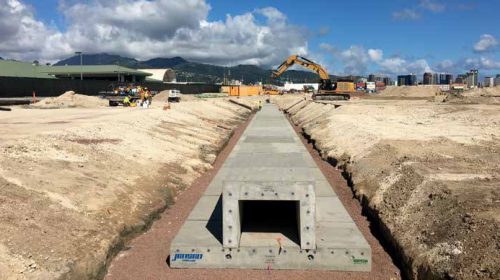The flow of cargo across the Pacific Ocean to the Hawaiian Islands began more than 3,000 years ago. Polynesians in wooden canoes carried plant cuttings and seeds to cultivate food, medicine, and fabric.
|
|
 |
| Jensen Precast Honolulu engineered the box culvert structures in line with Kapalama Container Terminal crane loads. |
 |
Today the islands host cargo ships from around the world filled with goods from every industry under the sun. Honolulu Harbor on Oahu is the hub of incoming freight to the archipelago. A lifeline to the state economy, it is at the heart of a $450 million initiative—the largest capital improvement project in the history of Hawaii’s commercial harbor system—to ensure state imports and exports continue to flow smoothly and efficiently.
Under a contract with Kiewit Infrastructure West Co., the Hawaii satellite operation of Sparks, Nev.-based Jensen Precast recently delivered robust concrete boxes for drainage and power infrastructure serving the harbor’s Kapalama Container Terminal. “Kapalama is the new home to Pasha Hawaii, one of the main shipping companies specializing in trade between Hawaii and the continental United States,” says Jensen Precast Honolulu General Manager Garret Lau. “The terminal is being upgraded as a part of Hawaii’s Harbors Modernization Plan. Our job features 4- x 3-ft. and 7- x 4-ft. box culvert structures engineered for the loadings of heavy cranes the facility uses to transfer cargo.”
Jensen Precast Project Manager Jorelle Flint devised the box culvert scheme and, for engineering expertise and estimating, turned to Product Design Manager Tom Elliott, who has managed the Kapalama Container Terminal contract. The producer’s Kalpolei plant, located less than an hour from the jobsite, delivered 96 of the 7- x 4-ft. and 62 of the 4- x 3-ft. structures. Fabricated with epoxy-coated rebar, the culvert sections will afford Kapalama Terminal operators durable storm and sewer systems, plus electric utility housing.
HARBORING COMMERCE
An estimated 80 percent of all goods consumed in Hawaii are imported, and 98 percent of them arrive through the commercial harbor system. The upgraded Kapalama Container Terminal will offer an 84-acre cargo yard and 1,800 linear feet of new berthing space.
The Port Hawaii commercial harbor system operates in hub-and-spoke mode with Honolulu Harbor on the island of Oahu, home to nearly 70 percent of Hawaii’s 1.4 million residents and the primary entry point for incoming cargo from the continental United States and foreign countries. From Honolulu, cargo is distributed to five other islands served by seven commercial harbor facilities. In fiscal year 2017, 234,879 domestic containers, 33,523 foreign containers, 327,709 inter-island containers, and 1.08 million passengers moved through Port Hawaii.
The Kapalama Container Terminal project spans two phases through a targeted 2022 completion. Phase I – Landside Construction commenced in Winter 2017, calling for the container yard, construction of support buildings, entry and exit gates, security fencing, parking, gantry cranes and container-handling equipment, on-site utilities, Hawaii Department of Transportation-Highways weigh station, plus pavement improvements. Hawaii DOT-Commercial Harbors awarded the $163 million Phase I contract to Kiewit Infrastructure West.
Work began last year on Phase II – Waterside Construction, to include a new pier with berthing capacity for two container ships; dredging along the waterfront and in the harbor channel; widening of the existing slip between Piers 40 and 41 from 256 to 300 feet to accommodate inter-island barges running up to 100 ft. wide and 400 ft. long; plus, additional piles and deck replacement.
